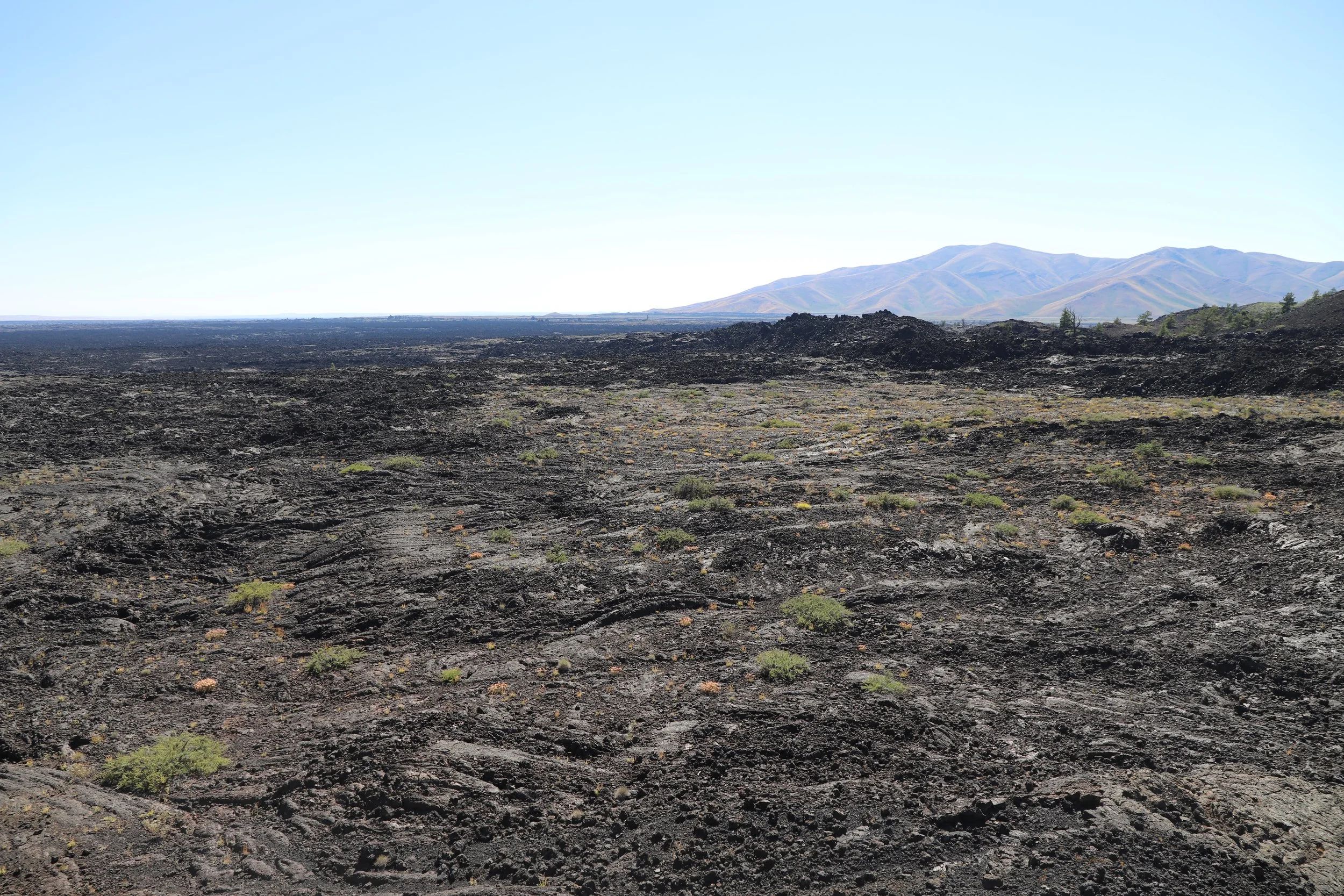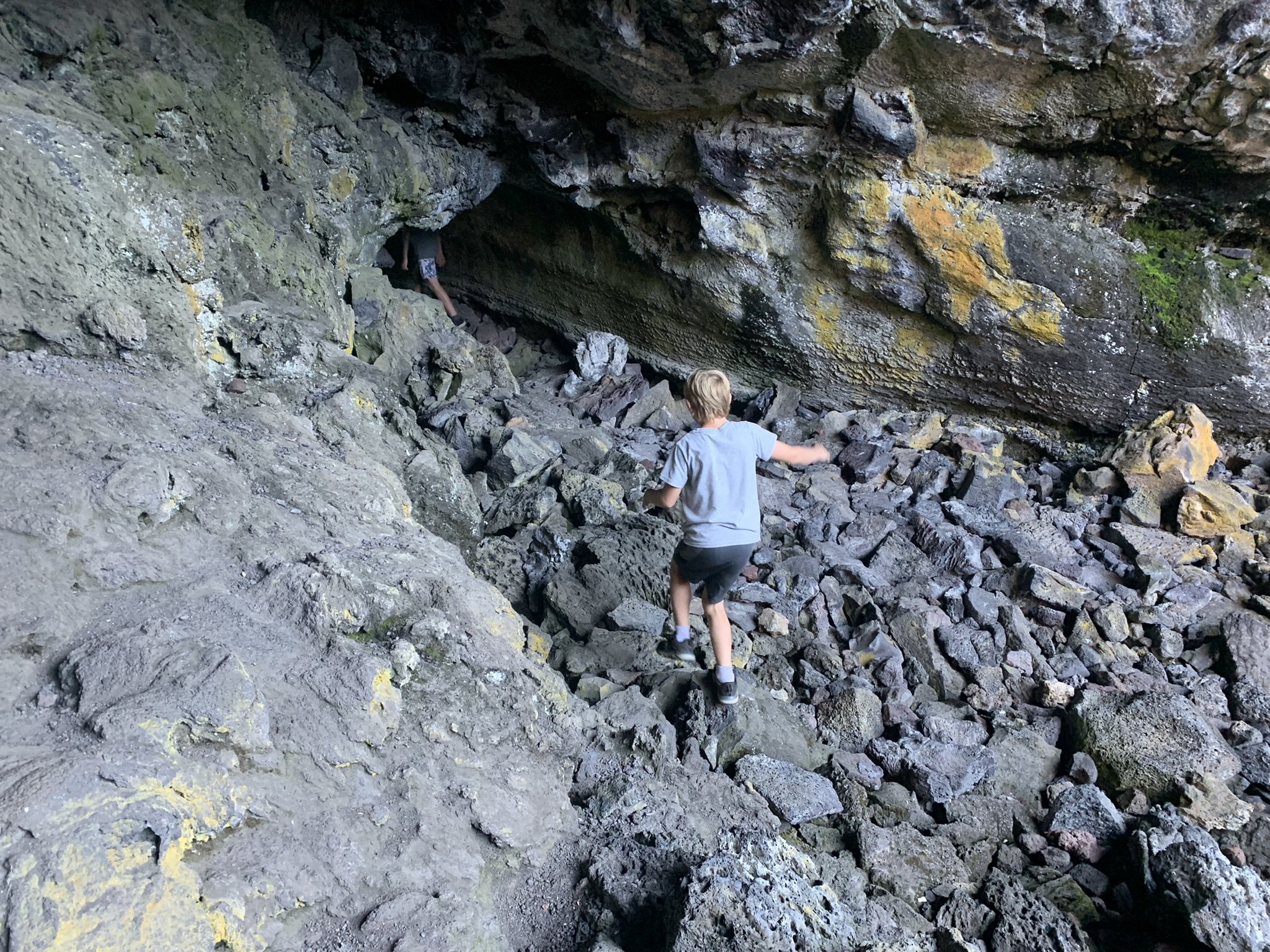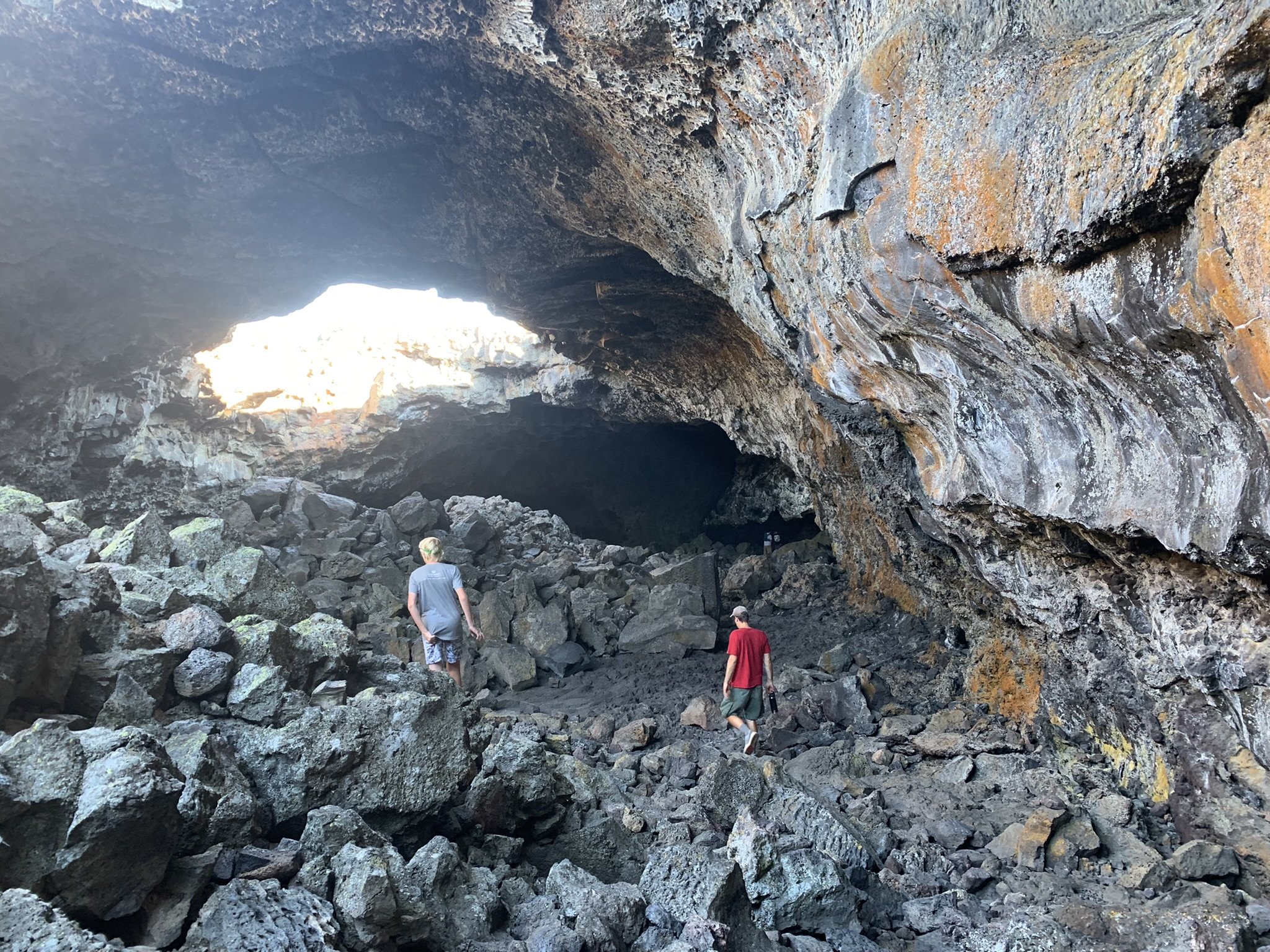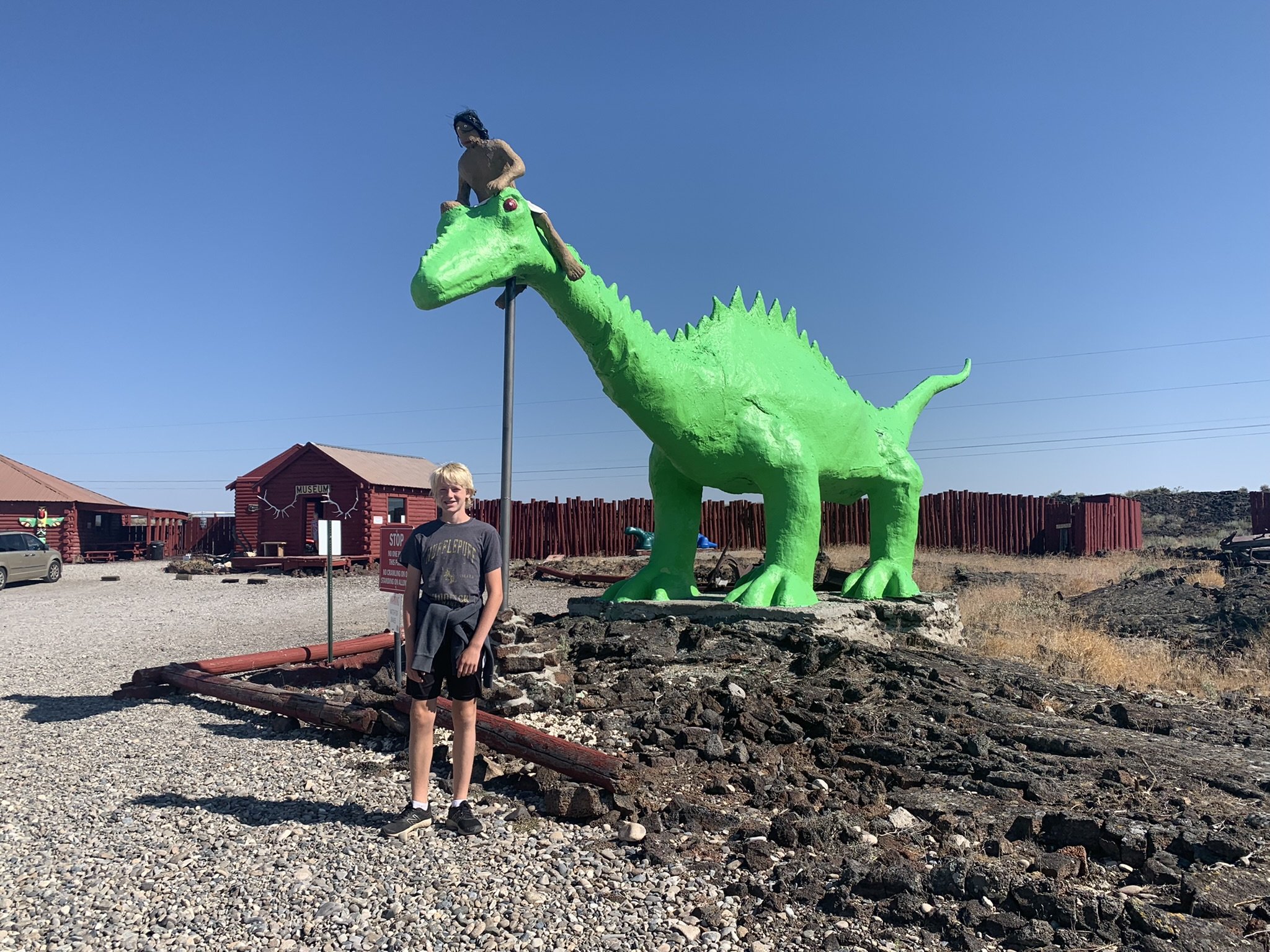Craters of the Moon - View from Spatter Cone
If you enjoy my posts, please consider signing up below to get email notifications of my latest blogs. I will not share your email.
Craters of the Moon - Indian Cave
Craters of the Moon National Monument
Most often, the places we choose to hike are beautiful and peaceful, stable and expected. Craters of the Moon is nothing like that. It’s raw, strange, largely barren, unknown, and unsettling. Most of the trails are paved - simply to keep your feet safe. This isn’t a park you’d likely travel to visit it on its own, but it’s a fascinating place to stop for a day if you find yourself traveling nearby.
We visited Craters of the Moon during our 17-day trip out west from Minnesota to the Washington National Parks in August 2020. I thought I was simply planning a hiking trip out west, but we ended up stumbling into an unexpected geological puzzle that involved volcanic activity our entire way to Washington. We used the term “hot lava” way more than I thought possible in our conversations.
If you want to piece together the volcanic history most clearly, it might help traveling east-to-west, and starting at Yellowstone National Park, where you can actually see today’s influence of hot lava interacting with Earth’s surface through steam creating the geysers and mud pots. We didn’t intentionally start our trip in Yellowstone, but it was on the way and our boys were so young the first time we visited that neither remembered. Both of our boys were fascinated in Yellowstone! As we travelled further west into Craters of the Moon, we learned that the hot spot that is now under Yellowstone, was previously under Craters of the Moon (about 8-10 million years ago) - the Earth’s crust (that makes up the continental United States) has been travelling slowly in a south-west direction. The lava though that you see on the surface at Craters of the Moon though is from much more recent eruptions (2,100 years ago).
Here is a link to my Yellowstone blog if you are interested: Yellowstone and Grand Tetons
Movement of the Earth’s crust over what is know Yellowstone’s Hot Spot
Planning Your Trip
Craters of the Moon - View from Inferno Cone
How to Visit the Lava Tube Caves
Before you get any further in this post, the most important part of planning your trip to Craters of the Moon is with respect to protecting sensitive bat populations. The coolest part of this National Monument is the lava tube caves. And bats live in these caves. To protect the bats that live in the park, you first need to make sure that you are wearing clothes (shoes or boots, pants, shirt, jacket, etc.) that have never been underground before (even in they’ve been washed since). Second, you need to start your trip at the Visitor Center to pick up a free permit to climb through the caves. The park rangers will go through the rules with you for how to protect the bats, and that includes reviewing your clothing. As you probably only have one pair of hiking boots, it’s good to know this requirement up front so you can buy a cheap pair of tennis shoes specifically for this day on your trip if you’ve previously visited a cave or other lava tube with your hiking boots.
Additionally, the only two lava tube caves that are open for exploration are Dew Drop and Indian Cave (when we travelled in 2020 and through at least 2023 as I write this blog). The other caves in the park are currently protected for the bats due to their declining populations.
How Much Time You Need
Craters of the Moon is a park that you can hike through in a day. There are nearby things to do that could add a second day (such as Black Magic Canyon, Shoshone Ice Cave, and Experimental Breeder Reactor National Historic Site), if you are interested. Beyond that, there isn’t much else near by. This is a pretty desolate section of the country.
Where to Go
Reference the below interactive map for the Crater of the Moon Visitor Center, trailhead locations, and other nearby things to do. Use two fingers on the map to zoom in and look around.
Craters of the Moon Lodging Options
The hardest part of planning a stop at Craters of the Moon is figuring out where to spend the night. If you camp, the easiest option is within the park itself (although there are no showers, and the campground is only open seasonally). Arco (with a population of less than 1000) is the closest town - about 20 minutes away from the park. There are a small number of local motels in Arco, as well as a few B&Bs in surrounding areas. There are also a small number of locally-owned cafes for food. We stayed at a cabin in the KOA in Arco and cooked our own food.
The closest larger cities are Boise, ID (2 hours and 45 minutes) and Salt Lake City, UT (3 hours and 40 minutes). Additionally, if you are coming from or going to Yellowstone, the west entrance of Yellowstone is about 4 hours away.
Nearby Black Magic Canyon - Lava Slot Canyon
Hiking at Craters of the Moon National Monument and Other Nearby Activities
The below map gives a high-level view of where the trailheads, viewpoints, Visitor Center, and other nearby things to do. Throughout the remainder of this post, I will use the same numbering system. Additionally, there are hyperlinks in the captions - if you click on the trail or activity name, it will bring you to the location in this post with pictures and more detailed descriptions. At the end of each section, there is a link back to this map.
Craters of the Moon Nation Park and Other Nearby Activities:
1 - Crater of the Moon Visitor Center
3 - Spatter and Snow Cone Trailhead
4 - Tree Molds Trailhead - Broken Top Hiking Loop with Big Sink Overlook
5 - Lava Tube Cave Trailhead - Dew Drop and Indian Caves
1 - Crater of the Moon Visitor Center
If you want to explore a lava tube cave, you will need to start your visit at the Robert Limbert Visitor Center. There will be a station set up to pick up your free permit, but you need to make sure that you arrive while the Visitor Center is open.
Within the Visitor Center, there is also a short video where you can learn about the park’s volcanic activity and the different types of lava that you will encounter. There is a small gift store within the Visitor Center as well.
2 - Inferno Cone
Craters of the Moon - View from Inferno Cone
Inferno Cone Trail (gray) and Spatter & Snow Cone Trail (red)
Distance - 0.5 mile out-and-back hike to the top of Inferno Cone
Elevation Gain - 150ft
Trail Info - Inferno Cone is a good trail to hike up to get a lay-of-the-land view of the park. This is a short trail that simply ascends up the lava rocks, as seen in the below picture. This is a barren section of the park until you get to the top. There is no hole at the top to peer down into; it’s flat. If you are looking for the hole at the top of a cone, check out the next hike below to Splatter and Snow Cones.
Trail going up to the top of Inferno Cone
Once you are at the top, there is a small amount of vegetation, and some pretty views of a stark landscape.
Lone tree at the top of Inferno Cone
That’s the whole trail. When you are done exploring at the top, you get to enjoy walking back down to yur car. We spent about 20 minutes along this trail.
Heading back down Inferno Cone
3 - Spatter and Snow Cones
Spatter Cone - Aa lava (like - “ah ah” - ouch, it would hurt if I walked on this)
Spatter & Snow Cone Trail (red) and Inferno Cone Trail (gray)
Distance - 0.25 mile out and back to both cones
Elevation Gain - 10ft
Trail Info - This is another short trail to explore what spatter cones looks like. You can peer inside of both cones, but climbing down into the cones is not allowed and the way in is blocked off by barricades. It’s also a pretty walk between the two cones. We spent about 15 minutes visiting both Splatter and Snow Cones.
Spatter Cone in Craters of the Moon
View looking down into Spatter Cone
Trail to Snow Cone
Pahoehoe lava along the trail to Snow Cone
Looking into Snow Cone
4 - Broken Top Loop with Big Sink Overlook
Broken Top Loop at Craters of the Moon
Map of Broken Top Loop at Craters of the Moon
Distance - 1.6 miles (+0.2 miles spur to Big Sink)
Elevation Gain - 90ft
Trail Info - To get to Broken Top, you will park at the Tree Molds Trailhead. This is an interpretive hike with sign posts throughout the trail. Check to see if there is a paper map that you can buy at the trailhead, which has the information for each sign post.
We hiked here for about an hour, and it was pretty without being strenuous. There was much more growth along this trail than the previous two, and the dark black lava rocks contrasted beautifully with the green plants. While exploring the loop, we found several curious shapes and patterns in the various lava rocks.
We ran out of time to add in the spur to the Big Sink Overlook. We’d traveled from Yellowstone, and the boys had surprised me by asking to walk on a few extra boardwalks that I hadn’t planned on in the morning, so we arrived at Craters of the Moon later than I expected in the afternoon. Wanting to make sure we had plenty of time to explore the caves, we skipped the viewpoint.
Lots and lots of lava
Broken Top Loop Trail
Patterns in the lava
Broken Top Loop Trail - Craters of the Moon
Broken Top Loop Trail near Buffalo Cave - which was closed off to exploration due to bat protection
Seems fitting to include an actual picture of the Moon while visiting Craters of the Moon National Monument
5 - Dew Drop and Indian Lave Tube Caves
Indian Cave - Lava Tube Cave at Craters of the Moon
Lava Tube Cave Trail - Dew Drop and Indian Caves
Distance - 1.5 miles
Elevation Gain - 35ft
Trail Info - This was my favorite spot in Craters of the Moon. We explored the caves for about an hour and a half. Make sure to bring a flashlight or headlamp so you can see everything you might be interested in. The light on your phone won’t be bright enough. Also, wear shoes or hiking boots (not sandals). As you climb into the caves, the bottom is going to be a bunch of small boulders that you will be climbing up and over, and these lava rocks can be sharp.
Trail out to the Lava Tube Caves at Craters of the Moon
Lava Tube Cave Trail
You will follow the paved trail from the parking lot, and Dew Drop will be the first cave. This cave is pretty but small. It’s also dark, and the descent into the lava cave requires more of a traditional cave feeling (compared with Indian Cave which is huge, airy, and you don’t really need a flashlight).
Climbing into Dew Drop Cave
Playing inside Dew Drop Cave
Indian Cave is a very large lava tube. If you look closely at my map, you’ll notice that we hiked in a loop. When you descend into Indian Cave, if you keep exploring, eventually you will hit a staircase on the other side that you can walk back up and then simply take the trail back.
Descending into Indian Cave
Climbing through Indian Cave
Inside Indian Cave
6 - Black Magic Canyon
Black Magic Canyon - Lava Slot Canyon
Hiking Map of Black Magic Canyon
Trailhead Location - The entrance to Black Magic Canyon is not quite an hour to the south and west of Craters of the Moon National Park. Typing “Black Magic Canyon” into GoogleMaps should get you to the parking lot marked by a kiosk. If for some reason that doesn’t work, then aim towards Shoshone, ID. The parking lot is west of ID-75, about 0.1 miles along W Magic Road / Watson Dr.
Distance - 0.5 miles out and back
Elevation Gain - 30ft
Trail Info - You are going to be entering a slot canyon. If it rains anywhere in the watershed, the water will end up in the slot canyon. Flash floods can happen extremely quickly. Don’t enter the canyon if it has been raining or may rain.
At the parking lot, there will be a kiosk with trail information and a short black top paved trail. Follow the trail until it ends at the river bed.
Beginning of the trail to Black Magic Canyon
Once you get to the river bed, you’ll need to get across it. The canyon starts at the other end. We were able to walk across on the edges over the rocks and were able to keep our feet dry.
Formal trail ends at the creek. Walk along the edges to get past the water.
On the other side of the water, you can see where the canyon starts. Just walk towards it and enjoy!
Beginning of Black Magic Canyon
We’ve been in several slot canyons, but Black Magic is the only slot canyon we’ve explored that is made of lava rock. It was gorgeous! And the rock formations were phenomenal. This is a short canyon, but really quite fun to explore.
Black Magic Canyon - Lava Slot Canyon
Water has worn odd shapes into the lava
Slot canyons are weird to begin with, but this one was other worldly
Towards the end the walls get pretty tight
The further you go, the tighter the spaces to squeeze through get
Eventually you won’t be able to go any further
Supposedly there is another section of Black Magic Canyon, I believe on the other side of the road. But we didn’t try to find that trailhead.
7 - Shoshone Ice Cave
Shoshone Ice Cave
Tour Location - Just a 3 minute drive from the Black Magic Canyon Trailhead is the Shoshone Ice Caves. This cave is privately owned, and cave tour tickets can be purchased online or at their gift store.
Shoshone Ice Cave Tour Start Location
There are cave tours where you learn about geology and tours with silly puns that are more of entertainment value. I would put this tour in the corny pun joke bucket; I learned more about how the ice was formed after buying a short book from their gift store. But getting to see ice inside of a cave in August in Idaho, when it was over 90 degrees outside, was worth the small tour ticket price. It’s the holes in the lava rocks that provide air insulation (like a Tervis mug), which keeps the caves colder and insulated from the above ground temperatures.
Entrance to the cave is a “caved-in” lava tube
Cave door entrances are sealed to protect the ice as the original natural entrance was destroyed years ago
Shoshone Ice Cave
Shoshone Ice Cave
8 - Experimental Breeder Reactor 1
I hadn’t heard of the Experimental Breeder Reactor until I checked into the KOA in Arco and the owner told me about it. If we would have known beforehand, we would have squeezed it into our agenda.
EBR-1 is about 40 minutes east of Craters of the Moon, and it’s a National Historic Landmark that offers tours of the reactors and control rooms in the summer. ERB-1 was the first power plant that created electricity from atomic energy.
Other Hiking Ideas
If you are looking for more hiking suggestions, please check out my below map with additional posts linked to each pin.





















































